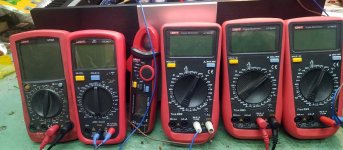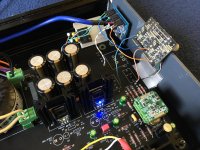Planning on buying a Brymen. Want the BM786, but the rational choice for me would be the BM235 🙂
Planning on buying a Brymen. Want the BM786, but the rational choice for me would be the BM235 🙂
Thrilled with my Brymen 869s which I learned about from one of the big comparison tables on the EEVBLOG forums.
Does anybody use a Sennheiser HD-560S with Whammy? I opted to get one of these instead of the DT 880 600 ohm's.
It's 120 ohms and very sensitive at 110db @10khz/1V RMS. I would like a sensible volume control, at least half a turn, and I'm contemplating reducing the gain by reducing the resistor values of R4 and R8 to 2.2k.
But if the volume control is usable from 6 o clock to 12 with the stock values that I have already installed, I'll not go through the hassle.
It's 120 ohms and very sensitive at 110db @10khz/1V RMS. I would like a sensible volume control, at least half a turn, and I'm contemplating reducing the gain by reducing the resistor values of R4 and R8 to 2.2k.
But if the volume control is usable from 6 o clock to 12 with the stock values that I have already installed, I'll not go through the hassle.
Last edited:
On the schematic it says "R39 and R40 can be changed to vary overall gain as a voltage divider with P1."
I lack the engineering knowledge to know what the math on that would be, or what the pros and cons would be between that and changing R4 and R8. I think the voltage divider just knocks down the input signal which I guess could cost you a little SNR.
There are resistor sockets available that would at least allow you to experiment without soldering and unsoldering the same pcb pads.
I lack the engineering knowledge to know what the math on that would be, or what the pros and cons would be between that and changing R4 and R8. I think the voltage divider just knocks down the input signal which I guess could cost you a little SNR.
There are resistor sockets available that would at least allow you to experiment without soldering and unsoldering the same pcb pads.
gain is A=1+(R8/R12) [V/V,Ohms]
see yourself for second channel, simple as that
if you want to change gain, alter R8 value
all ref to schm in post #1
see yourself for second channel, simple as that
if you want to change gain, alter R8 value
all ref to schm in post #1
Swifty - What does clock position have to do with the ability to drive Sennheiser? Turn the knob until you get the proper volume, you’ll have plenty of range. 
Many people use the higher impedance Sennhieser with Whammy and report outstanding results.

Many people use the higher impedance Sennhieser with Whammy and report outstanding results.
I am fearing that the sensitivity of the Senns will limit the travel range of the volume. If I have only 25% of a full turn on the volume knob, from whisper quiet to shatteringly loud, t will feel like I have to fiddle too much to comfortably change volume. A bit like having a stepped attenuator with too little steps.
Also, I often listen on moderate to low volume. I want to keep the volume pot in its range where the channels are matched best. I find that on their lower range, pots can be quite mismatched in volume per channel.
I am hoping that tailoring the gain resistor values will give me at least half a turn of control.
I will probably just add a gain switch.
Also, I often listen on moderate to low volume. I want to keep the volume pot in its range where the channels are matched best. I find that on their lower range, pots can be quite mismatched in volume per channel.
I am hoping that tailoring the gain resistor values will give me at least half a turn of control.
I will probably just add a gain switch.
Last edited:
Many people use the higher impedance Sennhieser with Whammy and report outstanding results.
It's not high impedance I'm worried about, it's the high sensitivity paired with the just moderate impedance. But I'm happy to tinker, so it will work out fine one way or the other. It's one of the many advantages of DIY 🙂
Last edited:
Another question: I am tapping directly into the 18v secondary rails for the power led, with added diode, cap, and resistor to tone it down, protect and rectify it. I tried without a cap, but to me the 50hz flicker is noticable. I settled on a 10uf cap as this makes the led turn off pretty quick, but also gets rid of the flickering.
The AC voltage is 21.4V. Am I ok to use a 25Vcap? Or will I have to take into account voltage spikes larger than the measured voltage?
The AC voltage is 21.4V. Am I ok to use a 25Vcap? Or will I have to take into account voltage spikes larger than the measured voltage?
Last edited:
Happy 6th birthday Whammy
I see from the original schematic on page 1 that the Whammy was conceived 6 years ago on 08/03/2015.
Slightly belated happy 6th birthday to Whammy.
I see from the original schematic on page 1 that the Whammy was conceived 6 years ago on 08/03/2015.
Slightly belated happy 6th birthday to Whammy.
In that case I made an anniversary edition 🙂 Although I just finished wiring it up this morning.
I ran into an issue: While there is no hum at all, and the right channel is quiet, there is a hiss in the left channel. Also, there are cracks and pops in the left channel when I plug in the head phone. When I turn Whammy off, you actually hear the capacitor discharge in that channel as well.
There is 17 volts on both rails, 570mV on both channels
Any pointers?
EDIT: I put on some music and the "quiet" channel hardly has any volume. Hence the silence 🙂 The hissing channel plays music, but at a volume that cannot be correct. I can turn the 10K Alps pot all the way open and the music is only moderately loud in the left channel.
Is it "well-lit and in-focus photos" time?
I ran into an issue: While there is no hum at all, and the right channel is quiet, there is a hiss in the left channel. Also, there are cracks and pops in the left channel when I plug in the head phone. When I turn Whammy off, you actually hear the capacitor discharge in that channel as well.
There is 17 volts on both rails, 570mV on both channels
Any pointers?
EDIT: I put on some music and the "quiet" channel hardly has any volume. Hence the silence 🙂 The hissing channel plays music, but at a volume that cannot be correct. I can turn the 10K Alps pot all the way open and the music is only moderately loud in the left channel.
Is it "well-lit and in-focus photos" time?
Last edited:
I've run into something similar in the past when I accidentally mixed wires with the 1/4" TRS jack. It was too easy for myself to overlook that due to my assumption being something less obvious. 😛
I solved it. I had installed a 0,1uf bypass cap on the underside of the opamp socket. As this was the only deviation from the original schematic, I started troubleshooting by removing this cap.
This solved the issue. I now only hear the faintest of hums when full open. at least half a turn beyond permanent hearing loss level. I'm happy.
She sounds absolutely wonderful, amazing stuff. I'll post some beauty shots later 🙂
This solved the issue. I now only hear the faintest of hums when full open. at least half a turn beyond permanent hearing loss level. I'm happy.
She sounds absolutely wonderful, amazing stuff. I'll post some beauty shots later 🙂
Last edited:
Another question: I am tapping directly into the 18v secondary rails for the power led, with added diode, cap, and resistor to tone it down, protect and rectify it. I tried without a cap, but to me the 50hz flicker is noticable. I settled on a 10uf cap as this makes the led turn off pretty quick, but also gets rid of the flickering.
The AC voltage is 21.4V. Am I ok to use a 25Vcap? Or will I have to take into account voltage spikes larger than the measured voltage?
That should be fine for the LED. You can convince yourself of this by looking up the cap's data sheet and seeing its derated value. I suspect you'll find the cap can handle 35v or thereabouts, and certainly for short pulses, without any issues. As to the value, I've personally used 47uf@50V and 47uf@35v rated in my 3 now for over a year with no issues.
--Tom
Just to say It's been a year since I made my version (18V, Nichicon and Clarity caps, Dale mil spec R's, Alps) And its used for hours everyday in my studio...... And I love it. Brilliant.
Here is my anniversary Whammy with a few toys. Dexa UWB regs, Muses Volume into Sjöström Super Buffers and the 994 Ticha op-amp.
The sound is remarkably good, the buffers are an experiment to practice using them, they will ultimately turn a power amp into an integrated and work very well. Perfect clear sound.
The sound is remarkably good, the buffers are an experiment to practice using them, they will ultimately turn a power amp into an integrated and work very well. Perfect clear sound.
Attachments
- Home
- Amplifiers
- Pass Labs
- "WHAMMY" Pass DIY headphone amp guide


